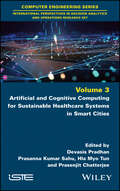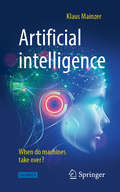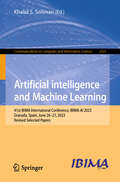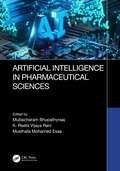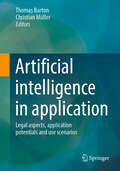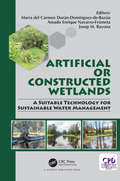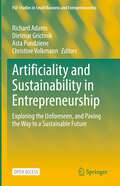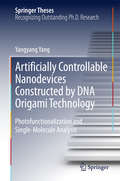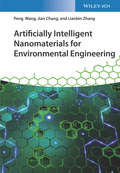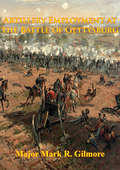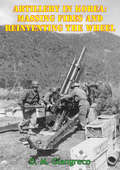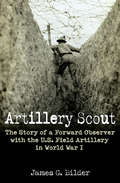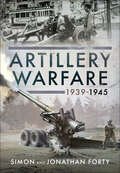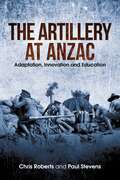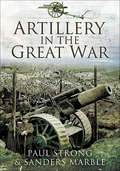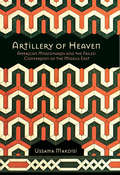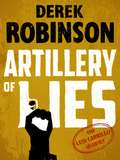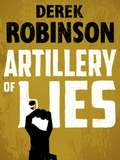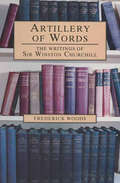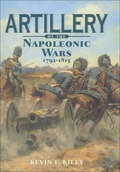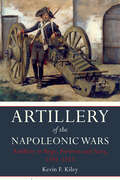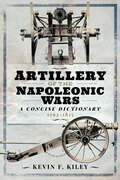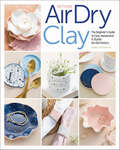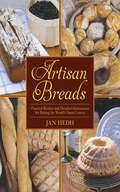- Table View
- List View
Artificial and Cognitive Computing for Sustainable Healthcare Systems in Smart Cities
by Prasenjit Chatterjee Devasis Pradhan Prasanna Kumar Sahu Hla Myo TunArtificial and Cognitive Computing for Sustainable Healthcare Systems in Smart Cities delves into the transformative potential of artificial and cognitive computing in the realm of healthcare systems, maintaining a specific emphasis on sustainability. By exploring the integration of advanced technologies in smart cities, the authors examine and discuss how AI and cognitive computing can be harnessed to enhance healthcare delivery. The book provides focused navigation through innovative solutions and strategies that contribute to the creation of sustainable healthcare ecosystems within the dynamic environment of smart cities. From optimizing resource utilization to improving patient outcomes, this comprehensive exploration provides insight for readers with an interest in the future of healthcare within the era of intelligent urban development.
Artificial intelligence - When do machines take over? (Technik im Fokus)
by Klaus MainzerEverybody knows them. Smartphones that talk to us, wristwatches that record our health data, workflows that organize themselves automatically, cars, airplanes and drones that control themselves, traffic and energy systems with autonomous logistics or robots that explore distant planets are technical examples of a networked world of intelligent systems. Machine learning is dramatically changing our civilization. We rely more and more on efficient algorithms, because otherwise we will not be able to cope with the complexity of our civilizing infrastructure. But how secure are AI algorithms? This challenge is taken up in the 2nd edition: Complex neural networks are fed and trained with huge amounts of data (big data). The number of necessary parameters explodes exponentially. Nobody knows exactly what is going on in these "black boxes". In machine learning we need more explainability and accountability of causes and effects in order to be able to decide ethical and legal questions of responsibility (e.g. in autonomous driving or medicine)! Besides causal learning, we also analyze procedures of tests and verification to get certified AI-programs. Since its inception, AI research has been associated with great visions of the future of mankind. It is already a key technology that will decide the global competition of social systems. "Artificial Intelligence and Responsibility" is another central supplement to the 2nd edition: How should we secure our individual liberty rights in the AI world? This book is a plea for technology design: AI must prove itself as a service in society.
Artificial intelligence and Machine Learning: 41st IBIMA International Conference, IBIMA-AI 2023, Granada, Spain, June 26–27, 2023, Revised Selected Papers (Communications in Computer and Information Science #2101)
by Khalid S. SolimanThis book constitutes the revised selected papers of the 41st IBIMA International Conference on Artificial intelligence and Computer Science, IBIMA-AI 2023, which took place in Granada, Spain during June 26-27, 2023. The 30 full papers and 8 short papers included in this volume were carefully reviewed and selected from 58 submissions. The book showcases a diverse array of research papers spanning various disciplines within the realm of Artificial Intelligence, Machine Learning, Information Systems, Communications Technologies, Software Engineering, and Security and Privacy.
Artificial intelligence in Pharmaceutical Sciences
by Musthafa Mohamed Essa Mullaicharam Bhupathyraaj Reeta Vijaya Rani, K.This cutting-edge reference book discusses the intervention of artificial intelligence in the fields of drug development, modified drug delivery systems, pharmaceutical technology, and medical devices development. This comprehensive book includes an overview of artificial intelligence in pharmaceutical sciences and applications in the drug discovery and development process. It discusses the role of machine learning in the automated detection and sorting of pharmaceutical formulations. It covers nanosafety and the role of artificial intelligence in predicting potential adverse biological effects. FEATURES Includes lucid, step-by-step instructions to apply artificial intelligence and machine learning in pharmaceutical sciences Explores the application of artificial intelligence in nanosafety and prediction of potential hazards Covers application of artificial intelligence in drug discovery and drug development Reviews the role of artificial intelligence in assessment of pharmaceutical formulations Provides artificial intelligence solutions for experts in the pharmaceutical and medical devices industries This book is meant for academicians, students, and industry experts in pharmaceutical sciences, medicine, and pharmacology.
Artificial intelligence in application: Legal aspects, application potentials and use scenarios
by Thomas Barton Christian MüllerThe book shows application potentials of artificial intelligence in various industries and presents application scenarios on how a practical implementation can take place. The starting point is the description of legal aspects, which includes a European regulation for artificial intelligence and addresses the question of the permissibility of automated decisions. The description of various application potentials, mostly industry-related, and the presentation of some application scenarios form the focus of the topic volume. The book is based on the question of how artificial intelligence can be used in entrepreneurial practice. It offers important information that is just as relevant for practitioners as for students and teachers. This book is a translation of an original German edition. The translation was done with the help of artificial intelligence (machine translation by the service DeepL.com). A subsequent human revision was done primarily in terms of content, so that the book will read stylistically differently from a conventional translation.
Artificial or Constructed Wetlands: A Suitable Technology for Sustainable Water Management
by María del Durán-Domínguez-de-Bazúa Amado Enrique Navarro-Frómeta Josep M. BayonaArtificial or constructed wetlands are an emerging technology particularly for tropical areas with water scarcity. For big cities, the sustainable management of water resources taking into account proper use is always challenging. The book presents case studies illustrating the above. As plants and microorganisms are a fundamental part of the correct functioning of these systems, their contribution to the degradation of the organic matter and to the removal and transformation of the pollutant compounds present in the wastewaters is also a highlight of this book.
Artificiality and Sustainability in Entrepreneurship: Exploring the Unforeseen, and Paving the Way to a Sustainable Future (FGF Studies in Small Business and Entrepreneurship)
by Richard Adams Dietmar Grichnik Asta Pundziene Christine VolkmannThis open access edited volume explores the past, present, and future of artificiality and sustainability in entrepreneurship – the unforeseen consequences and ways to advance to a sustainable future. In particular, it connects artificiality, sustainability and entrepreneurship, intertwining artificial with the specific phenomenon of those novel digital technologies that provoke continuous and significant change in our lives and business. Unlike digital entrepreneurship research, which focuses on digital technology development and management, this book covers processes and mechanisms of sustainable adaptability of entrepreneurs, the business logic of start-ups, and the collaborative behaviours under the mass digital transformation, including the prevalence of artificial intelligence. Some of the questions that this book answers are as follows: How has entrepreneurship reacted to such challenges previously? What lessons have been learned and need to be carried forward? How can entrepreneurship and the artefacts of entrepreneurship respond to current challenges? What should be the mindset of the entrepreneur to assure sustainable adaptation? How to embrace and embed the new business logic?
Artificially Controllable Nanodevices Constructed by DNA Origami Technology: Photofunctionalization and Single-Molecule Analysis (Springer Theses)
by Yangyang YangIn this book, the author deals mainly with two topics: (1) single-molecule visualization of switching behaviors in the DNA nanoframe system utilizing different kinds of molecular switches through the use of high-speed atomic force microscope (AFM); (2) construction of photocontrollable DNA nanostructures in programmed patterns and direct visualization of the dynamic assembling process. Here, high-speed AFM was employed to observe the dynamic movements of single molecules. Compared to a traditional single-molecule analysis method, such as fluorescence spectroscopy or electron microscopy, high-speed AFM makes possible the real-time observation of molecule behaviors. DNA nanostructures were designed and assembled as scaffolds to incorporate interested biomolecules. The observations were carried out under robust conditions without complicated pretreatment. Moreover, the photoresponsive molecules were successfully assembled into around 100 nm-sized DNA nanostructures. The assembly/disassembly of nanostructures can be regulated reversibly by photoirradiation. This book explains how DNA origami has gradually become a useful tool for the investigation of biochemical interactions in defined nanospace. It also shows the possibility of DNA nanostructures acting as nanodevices for application in biological systems, serving as a good introduction to basic DNA nanotechnology.
Artificially Intelligent Nanomaterials for Environmental Engineering: For Environmental Engineering
by Peng Wang Jian Chang Lianbin ZhangPresents novel, nanotechnology-based solutions for urgent environmental engineering problems Clear and concise from beginning to end, this book focuses on the design and application of artificially intelligent nanomaterials, which help in solving many tangible environmental problems?especially water and air pollution. It lays out the design concepts, major chemical principles, and materials considerations of artificially intelligent nanomaterials for environmental engineering, and provides proof-of-concept examples such as improved filtration membranes, nanofibrous air filters, and molecularly imprinted nanomaterials. Artificially Intelligent Nanomaterials: For Environmental Engineering starts by describing the background of environmental nanotechnology, the rise of Artificial Intelligence (AI), and the current status of AI in environmental engineering. It then looks at: intelligently functional materials and responsive mechanisms; designing filtration membranes with responsive gates; switchable wettability materials for controllable oil/water separation; and self-healing materials for environmental applications. The book continues with chapters that examine: emerging nanofibrous air filters for PM2.5 removal; self-propelled nanomotors for environmental applications; molecular imprinting in wastewater treatment; and emerging synergistically multifunctional and all-in-one nanomaterials and nanodevices in advanced environmental applications. -Presents the state-of-the-art in environmental technology and puts forward bold ideas for its advancement -Addresses global challenges, including all important water and air quality which are critical for human health and a sustainable future -Concentrates on nanotechnology-enabled solutions for pollutant removal from water and air Artificially Intelligent Nanomaterials: For Environmental Engineering is an ideal book for undergraduates, graduates, scientists, and professionals in the fields of environmental science, material science, chemistry, and chemistry engineering.
Artillery Employment At The Battle Of Gettysburg [Illustrated Edition]
by Major Mark R. GilmoreIncludes Civil War Map and Illustrations Pack - 224 battle plans, campaign maps and detailed analyses of actions spanning the entire period of hostilities.This book is an historical analysis of the Union artillery at the Battle of Gettysburg. It examines the significance of the Union artillery's contribution to the Federal victory. This study explores all aspects of the tactical employment of the Union artillery on the first and last days of the battle. A brief description of the evolution of artillery organization in the Army of the Potomac prior to the battle of Gettysburg is included. This is followed by the chronological presentation of the tactical employment of artillery during the battle. First its employment in the meeting engagement on 1 July is examined, followed by a study of its use on the final and decisive third day when Union forces fought a set-piece defensive battle. Among the conclusions arrived at during the course of this study are these: that the Army of the Potomac's corps artillery brigades and army artillery reserve proved to be responsive and efficient organizations in fulfilling their fire support mission, and when coupled with the skillful use of artillery and aggressive leadership by the army's Chief-of-Artillery, Brigadier-General Hunt, were crucial to the successful employment of the Union artillery forces. This study concludes that the Union artillery under the command of Brigadier General Henry Hunt had a decided and positive influence on the Federal victory by successfully employing its corps artillery brigades and army artillery reserve as part of a combined arms force.
Artillery In Korea: Massing Fires And Reinventing The Wheel [Illustrated Edition]
by D. M. Giangreco[Includes 10 photos illustrations]The first 9 months of the Korean War saw U.S. Army field artillery units destroy or abandon their own guns on nearly a dozen occasions. North Korean and Chinese forces infiltrated thinly held American lines to ambush units on the move or assault battery positions from the flanks or rear with, all too often, the same disastrous results. Trained to fight a linear war in Europe against conventional Soviet forces, field artillery units were unprepared for combat in Korea, which called for all-around defense of mutually supporting battery positions, and high-angle fire. Ironically, these same lessons had been learned the hard way during recent fighting against the Japanese in a 1944 action on Saipan, not Korea, aptly demonstrates. Pacific theater artillery tactics were discarded as an aberration after War World II, but Red Legs soon found that they "frequently [have] to fight as doughboys" and "must be able to handle the situation themselves if their gun positions are attacked." A second problem with artillery in Korea was felt most keenly by the soldiers that the artillery was supposed to support -- the infantry. Commanders at all levels had come to expect that in any future war, they would conduct operations with fire that equaled or even surpassed the lavish support they had recently enjoyed in northwest Europe. It was clear almost from the beginning, however, that this was not going to happen in Korea because there was a shortage not only of artillery units but also of the basic hardware of the cannoneers craft: guns and munitions. Until the front settled down into a war of attrition in the fall of 1951 (which facilitated the surveying of reference points and positioning of "an elaborate grid of batteries, fire direction centers, [and] fire support coordination centers"), massed fires were achieved by shooting at unprecedented speed.
Artillery Scout: The Story of a Forward Observer with the U.S. Field Artillery in World War I
by James G. Bilder“Moves quickly; it entertains and provides a decent overview of the life of an American Doughboy” on the Western Front during the Great War (San Francisco Book Review).The American Doughboys of World War I are often referred to as the “Lost Generation”; however, in this book, we are able to gain an intimate look at their experiences after being thrust into the center of Europe’s “Great War” and enduring some of the most grueling battles in US history.Len Fairfield, the author’s grandfather, was an Artillery Scout, or Forward Observer, for the US Army and was a firsthand witness to the war’s carnage as he endured its countless hardships, all of which are revealed here in vivid detail. His story takes the reader from a hard life in Chicago, through conscription, rigorous training in America and France, and finally to the battles which have become synonymous with the US effort in France—St. Mihiel and the Argonne Forest, the latter claiming 26,000 American lives, more than any other US battle.The American Expeditionary Forces endured a rare close-quarters visit to hell until it was sensed that the Germans were finally giving way, though fighting tooth-and-nail up to the very minute of the Armistice. This action-filled work brings the reader straight to the center of America’s costly battles in World War I, reminding us once again how great-power status often has to be earned with blood on battlefields.“All in all, this book is a bit of a gem. It is a well paced easy read and you will find yourself rooting for our hero.” —War in History
Artillery Warfare, 1939–1945
by Simon Forty Jonathan Forty“From mountain warfare with guns on mules to V2 rockets and everything between makes it well worth a place on anyone’s reference shelf.” —Clash of SteelIt is said that artillery won the Second World War for the Allies—that Soviet guns wore down German forces on the Eastern Front, negating their superior tactics and fighting ability, and that the accuracy and intensity of the British and American artillery was a major reason for the success of Allied forces in North Africa from El Alamein, in Italy and Normandy, and played a vital role in the battles of 1944 and 1945. Yet the range of weapons used is often overlooked or taken for granted—which is why this highly illustrated history by Simon and Jonathan Forty is of such value. They stress the importance of artillery on every front and analyze how artillery equipment, training and tactical techniques developed during the conflict.The selection of wartime photographs—many from east European sources—and the extensive quotations from contemporary documents give a graphic impression of how the guns were used on all sides. The photographs emphasize the wide range of pieces employed as field, antiaircraft and antitank artillery without forgetting self-propelled guns, coastal and other heavyweights and the development of rockets. The authors offer a fascinating insight into the weapons that served in the artillery over seventy years ago.“Superbly illustrated, this is testament to the courage and skills of extraordinary men in the execution of their duty. An amazing book.” —Books Monthly
Artillery at Anzac: Adaptation, Innovation and Education
by Chris Roberts Paul StevensA Simon & Schuster eBook. Simon & Schuster has a great book for every reader.
Artillery in the Great War
by Paul Strong Sanders MarbleA year-by-year examination of key WWI battles and how the ongoing advances in artillery shaped strategy, tactics, and oprations; includes battlefield maps! World War I is often said to have been an artillery war, yet the decisive role artillery played in shaping military decisions—and therefor the war itself—has rarely been examined. Artillery in the Great War traces the development of this all-important technology, the differing approaches to its use, the many innovations it underwent on both sides, and how those approaches and innovations in turn effected key battles such as the Battle of the Somme. This highly readable and informative history is perfect for any reader interested in understanding the legacy of World War I, or the evolution of modern warfare.
Artillery of Heaven: American Missionaries and the Failed Conversion of the Middle East (The United States in the World)
by Ussama MakdisiThe complex relationship between America and the Arab world goes back further than most people realize. In Artillery of Heaven, Ussama Makdisi presents a foundational American encounter with the Arab world that occurred in the nineteenth century, shortly after the arrival of the first American Protestant missionaries in the Middle East. He tells the dramatic tale of the conversion and death of As'ad Shidyaq, the earliest Arab convert to American Protestantism. The struggle over this man's body and soul—and over how his story might be told—changed the actors and cultures on both sides. In the unfamiliar, multireligious landscape of the Middle East, American missionaries at first conflated Arabs with Native Americans and American culture with an uncompromising evangelical Christianity. In turn, their Christian and Muslim opponents in the Ottoman Empire condemned the missionaries as malevolent intruders. Yet during the ensuing confrontation within and across cultures an unanticipated spirit of toleration was born that cannot be credited to either Americans or Arabs alone. Makdisi provides a genuinely transnational narrative for this new, liberal awakening in the Middle East, and the challenges that beset it.By exploring missed opportunities for cultural understanding, by retrieving unused historical evidence, and by juxtaposing for the first time Arab perspectives and archives with American ones, this book counters a notion of an inevitable clash of civilizations and thus reshapes our view of the history of America in the Arab world.
Artillery of Lies
by Derek Robinson1943. British Intelligence has finally got to grips with the Eldorado Network, Germany's most successful spy ring. It turns out to be one man in a small room in Lisbon, inventing phony (but convincing) reports. For two years he pulled the wool over German Intelligence's eyes, and made a killing.The British soon find that Eldorado's a real handful. They bring him to England, so they can manage his dispatches, and discover that living with a genius can be a headache. Eldorado rapidly creates a team of top sub-agents around him. None of them exists. But power--even imaginary power--is intoxicating, and he begins to treat his fake sub-agents as if real. Big trouble ahead.Artillery of Lies is the hair-raising sequel to The Eldorado Network, all the more funny for being soundly based on the true story of a real Second World War spy.
Artillery of Lies
by Derek Robinson1943. British Intelligence has finally got to grips with the Eldorado Network, Germany's most successful spy ring. It turns out to be one man in a small room in Lisbon, inventing phoney (but convincing) reports. For two years he has pulled the wool over German Intelligence's eyes, and made a killing. The British soon find that Eldorado's a real handful. They bring him to England, so they can manage his dispatches, and discover that living with a genius can be a headache. Eldorado rapidly creates a team of top sub-agents around him. None of them exists. But power - even imaginary power - is intoxicating, and he begins to treat his fake sub-agents as if real. Big trouble ahead. Artillery of Lies is the hair-raising sequel to The Eldorado Network, all the more funny for being soundly based on the true story of a real Second World War spy.
Artillery of Lies
by Derek Robinson1943. British Intelligence has finally got to grips with the Eldorado Network, Germany's most successful spy ring. It turns out to be one man in a small room in Lisbon, inventing phoney (but convincing) reports. For two years he has pulled the wool over German Intelligence's eyes, and made a killing. The British soon find that Eldorado's a real handful. They bring him to England, so they can manage his dispatches, and discover that living with a genius can be a headache. Eldorado rapidly creates a team of top sub-agents around him. None of them exists. But power - even imaginary power - is intoxicating, and he begins to treat his fake sub-agents as if real. Big trouble ahead. Artillery of Lies is the hair-raising sequel to The Eldorado Network, all the more funny for being soundly based on the true story of a real Second World War spy.
Artillery of Words: The Writings of Sir Winston Churchill
by Frederick WoodsAn analysis of the writings of the iconic twentieth-century statesman from the author of Young Winston&’s Wars. Only a part-time author, Sir Winston Churchill wrote fifty books and over eight hundred feature articles. He even received the Nobel Prize for Literature in 1953. Now, Frederick Woods, an internationally acknowledged expert in the field of Churchillian writings, presents a full-length appraisal of Churchill&’s literary output, while putting the writings in the context of Churchill's public life. Churchill&’s words were weapons, argues Mr. Woods, written deliberately to win a battle, whether that battle was over the future of India, the fate of the freedom-loving world, the rehabilitation of renowned ancestors, or his own fluctuating reputation. In every case Churchill strove mightily to win, and often presented his case with less objectivity than that expected of one popularly considered to be a major historian. Artillery of Words is not only an illuminating and often witty analysis of Churchill&’s writings; it is also an important and revealing contribution to Churchillian studies in general. Praise for Frederick Woods&’s A Bibliography of the Works of Sir Winston Churchill &“[Reveals] a mastery of both research and presentation.&” —Martin Gilbert, bestselling author of Churchill: A Life
Artillery of the Napoleonic Wars, 1792–1815: Volume I - Field Artillery, 1792-1815 (Napoleonic Library)
by Kevin F. KileyAn extensive look at the large-caliber guns of the Napoleonic period, the battles in which they were used, and the important figures in those conflicts. In this heavily researched study, Kevin Kiley examines Napoleon&’s own artillery as well as that employed by his enemies, and he evaluates the gunners&’ contribution to warfare in the period. By looking at particular battles in detail, Kevin Kiley shows just how the effective employment of artillery could tip the scales of victory.Artillery of the Napoleonic Wars reveals much of the technical aspects of gunnery during the period—how guns were placed, their range, what calibers were preferred, how artillery operates. It examines French artillery, including that of the Imperial Guard, and compares it to that of Britain, Russia, and Austria; it also looks at many of the personalities involved and the difference between good gunnery and mediocre artillery. Illustrated with beautiful line drawings and rare contemporary plates, this unique book reveals a whole new dimension to the Napoleonic period. Based on years of research into regulations of the period, eyewitness accounts of artillerymen, and material culled from official reports, this is a definitive account.&“This must undoubtedly become the standard work for anyone interested in the artillery of the period.&” —Waterloo Journal
Artillery of the Napoleonic Wars: Artillery In Siege, Fortress And Navy 1792-1815
by Kevin F. Kiley&“Filled with statistical information on the guns, ammunition, and carriages, used by the armies . . . places the reader on the ground with the gunners.&”—The Napoleon Series Napoleon was an artilleryman before he was an emperor. He understood the power and effectiveness of cannon and their ability to pulverize defenses, reduce fortresses and destroy attacks. In return, the guns won Napoleon battles. This impressive study chronicles the story of the guns and men during the twenty-three years of almost continuous warfare from 1792–1815: from the battlefields of continental Europe to the almost primitive terrain of North America and of the seas, lakes and rivers that connected them. Detailed technical information is accompanied by vivid descriptions which allow the reader to imagine what it must have been liked to maneuver and man the guns in a variety of situations—whether on the march or on the battlefield. Based on years of research into regulations of the period, eyewitness accounts of artillerymen and material culled from official reports, the scope and depth of material will satisfy the serious researcher, while the lively narrative will appeal to the casual reader. &“Kiley&’s research is impeccable and deserves the highest praise. Moreover, he writes in so entertaining a manner that he informs and educates without effort . . . For the enthusiastic student of the attack and defense of fortified places this is an essential book of reference.&”—Fortress Study Group
Artillery of the Napoleonic Wars: Volume I - Field Artillery, 1792-1815 (Napoleonic Library)
by Kevin F. KileyA comprehensive military history reference book exploring all aspects of the artillery used during the Napoleonic Wars.Napoleon began his military career as an artillery cadet and artillery played a fundamental part in all his great battles. Until the Napoleonic Wars artillery had been seen merely as a supporting arm to the infantry, but Napoleon changed everything. He massed his guns in huge batteries to blast holes in his opponent’s line. He even used the artillery to charge the enemy, the gunners galloping up to the enemy to open fire at pointblank range.Napoleon’s opponents did not all follow suit, choosing other tactical deployments. As a result, the Napoleonic era, more than any that preceded or followed it, was one of fascinating artillery maneuvers and critical actions that changed the course of many of the key battles. As the Prussian Field Marshal Blucher once observed, “Against Napoleon you needed guns – and lots of them!”The Napoleonic Wars was also a time of innovation, with the introduction of shrapnel shells and military rockets. This book will examine the artillery arms of all sides from ‘muzzle to butt plate’. As well as the significant artillerymen of the period, the scientists, and innovators, military and civilian—individuals such as Robins, Belidor, Gribeauval and his colleagues, Maritz, Liechtenstein and his collaborators, as well as the du Teil brothers – will all be examined, as will the important battles and sieges, significant memoirs and documents, and artillery terms that soon became part of the military lexicon.Written by the renowned historian Kevin F. Kiley, this will be the definitive book on the subject and will cover all aspects of artillery in the Napoleonic Wars.“This is a wonderfully complete induction into the details of Napoleonic Artillery. As well as defining some of the archaic terms associated with the art of gunnery (note; point blank is not what we mostly believe it to be) it provides background to the careers of the key characters in the science. The book contains many excellent technical drawings to explain, sketches and images to inform and data tables in the appendix to which to refer. Overall, it is an indispensable aid to understanding the artillery of the period.” —Michael McCarthy, battlefield guide
Artisan Air-Dry Clay: The Beginner's Guide to Easy, Inexpensive & Stylish No-Kiln Pottery
by Radka HostasovaNo Kiln? No Problem! Learn to make beautifully textured home décor accents with inexpensive air-dry clay! The process is easy, and the results are surprisingly stylish when you follow the tips, advice, and instruction from author and clay artist-designer Radka Hostasova. Aimed at absolute beginners—this book starts with an overview of the tools and materials needed to produce the best results. A comprehensive "Getting Started" chapter teaches essential home pottery techniques such as rolling slab, coiling, sculpting, and pinching. Also included are creative ideas for adding color with acrylic paint, watercolor, and metallics. At the book's heart are a range of beautiful projects, including trinket bowls, napkin rings, wall hangings, coasters, and others. Each lesson comes with a detailed reference photograph and easy-to-follow step-by-step instructions. Roll, coil, sculpt and carve air-dry clay to create beautiful projects Make modern and stylish projects such as coasters, trinket dishes, home décor accents, kid's projects, and more Use easy home pottery as a mode of relaxation and stress relief
Artisan Breads: Practical Recipes and Detailed Instructions for Baking the World's Finest Loaves
by Jan HedhIn this beautifully photographed book, master baker Jan Hedh teaches us the basics for baking delicious artisan breads right in our own ovens. Hedh offers a cookbook full of recipes for all occasionsOCofrom daily loaves for sandwiches to delectable sweet breads for special occasions. This cookbook includes master tips on how to bake bread for maximum taste and aroma, the proper way to knead dough, the type of flour to use, and the correct baking time and oven temperature. With his wide breadth of recipes from all over the worldOCoincluding Italian, French, Swiss, German, Arabic, and of course Swedish breadsOCothis book is a must-have for all those who love to bake. "
